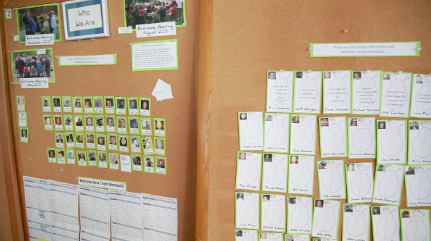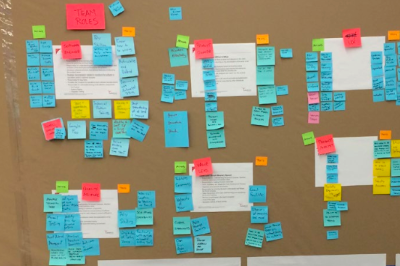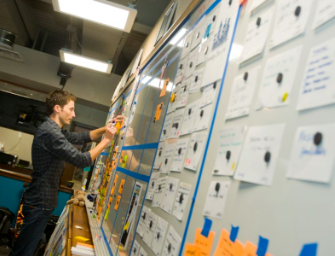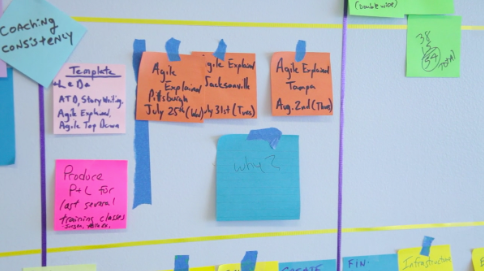How to Make an Effective Information Radiator
by Todd Cotton, on Jan 2, 2020 10:31:06 AM

Break down information silos, and get important information out in the open.
When teams use information radiators effectively, they are more collaborative, transparent, accountable, and, ultimately, efficient. Key processes and workflows are pulled out of files hidden on servers and plastered on a wall to remove obstacles to productivity and communication.
Whether you are new to the information radiator concept, or your experience with them has not yielded the expected results, you’ll discover how to ensure your big visual charts carry out the agile principles and values to create your desired outcomes.
What is an information radiator?
An information radiator is a big visual chart placed in a prominent location. It conveys key information and shows the health of a team. It is used to visualize the flow of work, shows where bottlenecks (or blockers) occur, and enables anyone to see what the team is working on at any time.

Each information radiator is unique, but common principles are used across the most successful ones.
An information radiator is one tactic used to implement the agile methodology. Learn about the agile approach, including other common processes, in our guide, “The Agile Approach, Process and Models.”
What makes an effective or ineffective information radiator?
Not all information radiators are created equal. It’s not about throwing information on a wall in your office and declaring your team agile.

These are the seven qualities of successful information radiators.
1. Effective information radiators are customized to the team—by the team; ineffective ones are rigid and prescriptive.
How do you create an information radiator? First, the whole team should make it together. It can’t be contrived by management and presented to the team as a finished product.
What should be included in the information radiator?
Each information radiator should be tailored to the team, but you can start with common boards and customize them from there:
- Backlog board. This is the ultimate to-do list, an ordered list of tasks the team will work on over the next week and beyond. Prioritization of the backlog board is critical.
- Work-in-progress (WIP) board. The WIP board shows what the team is actively working on. It may be a Kanban board featuring WIP limits and tasks pulled from column to column as the team has capacity. Or, for scrum teams, you’ll want a storyboard that shows your flow, including a backlog of stories to be completed during the sprint.
- Calendar. This documents the team’s collective schedule of events—potentially including regular meetings, special events, or your sprint/iterations and ceremonies.
- Artifacts or team documents. You may use a different term, but these are the documents that a team has agreed upon together. It often includes a working agreement, a definition of ready, and a definition of done.
- Obstacle board. Since an information radiator should express what’s in progress, an obstacle board can clearly show what is creating roadblocks. With an obstacle board, management can walk past and immediately understand what’s holding the team up, creating a dialogue to overcome these issues.
While these boards are a good place to start, an information radiator must be personalized. It’s only effective if the information is relevant to the team.

2. Effective information radiators only display the most important information; ineffective ones are overly detailed.
To be useful, an information radiator must strike a balance between comprehensiveness and simplicity. As the team designs the boards, if a concept is considered “nice to have” vs. “a must have,” skip it. Overly-detailed boards can become a chore for the team, or will be ignored in time.
Also, by limiting the information radiator to the most important information, it focuses conversation on the things that matter. These conversations enhance collaboration and keep everyone on the same page.
3. Effective information radiators are simple; ineffective ones are unnecessarily complex.
When it comes to design, the information radiator must be simple. As a tool of collaboration and a conversation starter for executives and colleagues outside of the team, anyone should be able to quickly understand it.
Why? Because we want the visual tool to create conversation, and complexity can inhibit this. We also want it to be quick to review, not a time-intensive task.

4. Effective information radiators are big and visible; ineffective ones don’t stand out.
Literally, your information radiators need to be big. They need to be a can’t miss piece of art on your wall.
Think of it like this giant, light-up “BEER” sign located on top of Market Garden Brewery in Cleveland. You can’t walk by without looking at it and at least thinking about sipping a cold one.

Your information radiator should have the same effect. Your team, management, and executives should stop when they see the big visual charts, encouraged to think about the story it tells.
5. Effective information radiators are regularly updated; ineffective ones go stale.
Just like that sticky note you’ve had stuck next to your computer with an “important” reminder for months, if your information radiator is stagnant, it loses effectiveness. Without regular updates, teams stop reaping the benefits of a big visual chart.
How do you make sure it remains regularly updated?
- Everyone should have a defined role for updating the board. For example, it’s the product owner’s job to prioritize the backlog, developers must move their own stories through the WIP board, and everyone contributes to the obstacle board as needed. These roles create accountability across the team.
- Revisiting the boards should be part of your regular retrospective or review process. Whatever your process for working, your team should regularly analyze those processes in order to continuously improve. A discussion about information radiators should be a part of that.
6. Effective information radiators change as the team changes; ineffective ones don’t.
By revisiting the information radiator’s effectiveness regularly, you ensure that it never becomes outdated. This is especially necessary as the team’s makeup or it’s processes change.
For example, if the team realizes it needs to shift its process from Scrum to Kanban, the board must be updated accordingly. Or, if a new team member is added or removed, the working agreement may need to shift to accommodate.
This all comes back to a crucial information radiator best practice: Information radiators must be customized by the team and for the team.
7. Effective information radiators are handmade, or are entirely visible (if digital); ineffective ones require effort to see completely.
For teams without existing software, we create hand-made information radiators, using sticky notes and other tangible tools. The tactile nature of moving a story from column to column as it approaches completion is rewarding. It also requires team members to get up and move around throughout the day, positively affecting productivity and overall happiness.
However, there are a suite of agile software platforms that are convenient for remote teams and have powerful capabilities to help teams work better.
To recognize the benefits of an information radiator while also using software, consider using a large screen or projector placed in the same location a handmade one would be. If you need to open up a separate file or zoom in and out of a giant digital “information radiator” on your laptop, it’s not an information radiator.
It must be large, highly visible and still follow the best practices outlined in this post.
See how information radiators support the larger agile methodology.
Information radiators are one narrow, but important tactic to achieving agile transformation. Learn about how it fits into the larger concept of agile by downloading the Agile Discussion Guide.
About the Author
 Todd Cotton is a LeanDog agile coach whose passion is to help organizations create more fulfilling work environments that result in happier, satisfied employees. He’s currently an integral part of an agile transformation taking place at a Fortune 500 bank.
Todd Cotton is a LeanDog agile coach whose passion is to help organizations create more fulfilling work environments that result in happier, satisfied employees. He’s currently an integral part of an agile transformation taking place at a Fortune 500 bank.
Previously, Todd helped lead a multi-year agile transformation at PNC and National City Bank. In total, he has 30+ years of IT and development experience, has managed multi-million dollar projects, and has led teams of 100+. Todd is an Advanced Certified ScrumMaster (A-CSM) and a SAFe® 4 Certified Agilist.
Read more posts from Todd. Connect with Todd on LinkedIn.




